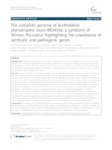Use este identificador para citar ou linkar para este item:
http://www.alice.cnptia.embrapa.br/alice/handle/doc/991675| Título: | The complete genome of Burkholderia phenoliruptrix strain BR3459a, a symbiont of Mimosa flocculosa: highlighting the coexistence of symbiotic and pathogenic genes. |
| Autoria: | ZULETA, L. F. G.  CUNHA, C. de O.   CARVALHO, F. M. de   CIAPINA, L. P.   SOUZA, R. C   MERCANTE, F. M.   FARIA, S. M. de   BALDANI, J. I.   STRALIOTTO, R.   HUNGRIA, M.   VASCONCELOS, A. T. R. de   |
| Afiliação: | LUIZ FERNANDO GODA ZULETA, LNCC; CLÁUDIO DE OLIVEIRA CUNHA, UFCE / CNPQ; FABÍOLA MARQUES DE CARVALHO, LNCC; LUCIANE PRIOLI CIAPINA, LNCC; RANGEL CELSO SOUZA, LNCC; FABIO MARTINS MERCANTE, CPAO; SERGIO MIANA DE FARIA, CNPAB; JOSE IVO BALDANI, CNPAB; ROSANGELA STRALIOTTO, CNPAB; MARIANGELA HUNGRIA DA CUNHA, CNPSO; ANA TEREZA RIBEIRO DE VASCONCELOS, LNCC. |
| Ano de publicação: | 2014 |
| Referência: | BMC Genomics, v.15, p. 535, Jun. 2014. |
| Conteúdo: | Burkholderia species play an important ecological role related to xenobiosis, the promotion of plant growth, the biocontrol of agricultural diseases, and symbiotic and non-symbiotic biological nitrogen fixation. Here, we highlight our study as providing the first complete genome of a symbiotic strain of B. phenoliruptrix, BR3459a (=CLA1), which was originally isolated in Brazil from nodules of Mimosa flocculosa and is effective in fixing nitrogen in association with this leguminous species. Genomic comparisons with other pathogenic and non-pathogenic Burkholderia strains grouped B. phenoliruptrix BR3459a with plant-associated beneficial and environmental species, although it shares a high percentage of its gene repertoire with species of the B. cepacia complex (Bcc) and "pseudomallei" group. The genomic analyses showed that the bce genes involved in exopolysaccharide production are clustered together in the same genomic region, constituting part of the Group III cluster of non-pathogenic bacteria. Regarding environmental stresses, we highlight genes that might be relevant in responses to osmotic, heat, cold and general stresses. Furthermore, a number of particularly interesting genes involved in the machinery of the T1SS, T2SS, T3SS, T4ASS and T6SS secretion systems were identified. The xenobiotic properties of strain BR3459a were also investigated, and some enzymes involved in the degradation of styrene, nitrotoluene, dioxin, chlorocyclohexane, chlorobenzene and caprolactam were identified. The genomic analyses also revealed a large number of antibiotic-related genes, the most important of which were correlated with streptomycin and novobiocin. The symbiotic plasmid showed high sequence identity with the symbiotic plasmid of B. phymatum. Additionally, comparative analysis of 545 housekeeping genes among pathogenic and non-pathogenic Burkholderia species strongly supports the definition of a new genus for the second branch, which would include BR3459a. The analyses of B. phenoliruptrix BR3459a showed key property of fixing nitrogen that together with genes for high tolerance to environmental stresses might explain a successful strategy of symbiosis in the tropics. The strain also harbours interesting sets of genes with biotechnological potential. However, the resemblance of certain genes to those of pathogenic Burkholderia raise concerns about large-scale applications in agriculture or for bioremediation. |
| Thesagro: | Fixação de Nitrogênio |
| ISSN: | 1471-2164 |
| Digital Object Identifier: | 10.1186/1471-2164-15-535 |
| Tipo do material: | Artigo de periódico |
| Acesso: | openAccess |
| Aparece nas coleções: | Outras publicações (CNPSO)  |
Arquivos associados a este item:
| Arquivo | Descrição | Tamanho | Formato | |
|---|---|---|---|---|
| BR3459.pdf | 3,17 MB | Adobe PDF |  Visualizar/Abrir |









